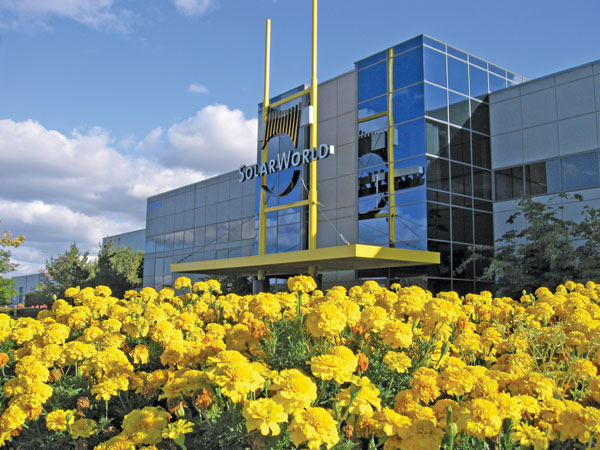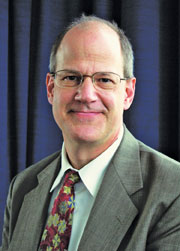When SolarWorld AG leaders announced on Oct. 31, 2014, that the company was expanding both solar-panel and high-efficiency monocrystalline cell production at its plant in Hillsboro, Ore., they did so in the presence of US Senator Ron Wyden, chairman of the Senate Committee on Finance, who supports SolarWorld Industries America Inc.’s trade cases against dumping from Asia. Those cases took an important step forward in mid-December, when the US Dept. of Commerce announced it would impose anti-dumping duties higher than 50 percent on US imports of solar power products from China and about 20 percent from Taiwan.
“The US government is serious in taking action against illegal dumping from China,” said Dr.-Ing. E. h. Frank Asbeck, CEO of SolarWorld AG, which employs 3,400 people worldwide. The Commerce decision is the second-to-last step to finalized duties in the US, on which the US International Trade Committee will decide at the end of January 2015.
In Hillsboro, SolarWorld operates the largest solar photovoltaics production facility in the United States, complementing production in Freiberg and Arnstadt, Germany. In the third quarter of 2014, the growing US solar market — where demand was anticipated to rise by 30 percent in 2014 and in 2015 — accounted for more than 40 percent of SolarWorld’s sales. Thus the production expansion, which takes capacity from 380 to 530 megawatts (MW) with the option to expand up to 630 MW.
In early December, Ben Santarris strategic affairs director, responded to questions from Site Selection.

SolarWorld’s efforts at its Hillsboro complex and in world trade cases are paying off at the same time.
Photo courtesy of SolarWorld
Site Selection: When we reported on SolarWorld’s initial investments in Oregon five years ago, your executives listed chief advantages as state incentives, a great facility (formerly owned by Komatsu), a workforce and vendor network in place from the semiconductor industry, and community college assistance with training. How, if at all, have these factors changed or evolved?
Ben Santarris, SolarWorld: Especially amid our aggressive initial employment ramp after we opened our doors in Hillsboro in October 2008 — we hired nearly 1,000 workers in about two years — the semiconductor industry has done much to supply workers for our factories here. In particular, the chip industry helped seed our management ranks with top silicon-industry expertise that we needed to build our own silicon-based manufacturing operations in Hillsboro. Portland Community College was particularly responsive in this effort by supporting training among the ranks of our production operators and technicians.
Since then, trade aggression from the Chinese government and its state-sponsored solar industry has deeply and unfairly thinned the ranks of the US domestic solar-manufacturing industry up and down the value chain. While the region surrounding Portland remains as strong as ever as a world capital of silicon-industry innovation and manufacturing, thanks especially now to the continuing growth of industry giant Intel on several campuses, the solar industry and its supply chain in the region and country as a whole have considerably dwindled. For the past three and a half years, SolarWorld has led a trade battle on behalf of the domestic manufacturing industry to curb improper trade practices of the Chinese industry, and its success on that front recently has shown signs of reigniting growth in US solar manufacturing and its supply chain.
State incentives helped at the margin to defray some of SolarWorld’s initial investments, but the company has completed those programs, and it never received federal subsidies to support its investment of well over $600 million of its own money to build up its operations in Hillsboro.
SS: Describe how the company’s facility investment and hiring goals have been affected by the ongoing trade cases.

Ben Santarris, Strategic Affairs Director, SolarWorld Americas Inc.
Santarris: After years of solar-industry bankruptcies, factory closures and downsizings in the wake of the Chinese trade aggression, SolarWorld stands as the only significant solar-industry manufacturer remaining in both the Americas and Europe — in fact, the only one outside of Asia. But its continued strength has not come without arduous trials, which have included a comprehensive corporate structuring, a factory shutdown in California, several rounds of layoffs in Hillsboro and a US corporate consolidation.
While SolarWorld operated on an austerity footing through the hardest times of the industry’s crisis, it managed to make a well-calculated $27-million investment in advanced solar-cell production in 2012. This investment enabled the company to re-assert its technological leadership in producing high-efficiency solar cells and panels. Recently, the company announced it would invest more than an additional $10 million to expand that production as well as increase capacity of module production. Thanks to these successes, the company, which peaked at 1,355 workers in April 2011 before slumping amid the industry’s collapse, expects pending production expansions to boost its payroll by about 200 workers to reach a total US head count of about 900 in mid-2015. So the company’s strength and its hiring are both on the upswing.
SS: How would expected favorable rulings influence further investment by SolarWorld, whether in Oregon, Germany or elsewhere?
Beyond
Expectations
In October 2014, Nike certified to the state of Oregon that more than 2,000 new full-time equivalent employees had been hired since January 1, 2012, satisfying an agreement made with the state of Oregon to hire at least 500 FTEs by the end of 2016 as part of rules adopted in the 2012 Special Legislative Session to support Nike’s headquarters expansion near Beaverton.
On Jan. 1, 2012, Nike had 6,625 FTEs at its Oregon World Headquarters facilities, excluding its in-house manufacturing, retail field, and temporary and seasonal employees. As of Sept. 30, 2014, Nike employed 8,709 FTEs at its Oregon World Headquarters facilities with the same exclusions.
“NIKE has gone above and beyond our expectations by expanding its workforce by far more than was asked of them,” said Gov. John Kitzhaber. “NIKE’s commitment to economic prosperity here in the state is made clear by the investment the company is making in both existing and new employees.”
Santarris: Favorable preliminary rulings already have helped to turn the tide moving back toward fair competition within the US solar industry. This development has proved promising not only for SolarWorld in terms of sales, but also for a number of companies announcing or considering new manufacturing investment on US soil. At the time of this interview, however, we await final duty determinations and case decisions that we expect the US government to finalize in late January. SolarWorld already has announced 2015 expansions and signaled that it expects to make more announcements as the US solar market develops along the way.
Historic Step
The semiconductor sector whose resources have been so favorable for SolarWorld in Oregon is doing its part to grow as well. In August 2014, Intel announced it will propose a $100-billion investment in Washington County through the state’s Strategic Investment Program that would retain the company’s 17,500 employees at the site.
Recent analysis by ECONorthwest revealed that each of Intel’s jobs in Hillsboro and Washington County created an additional three non-Intel jobs throughout the state. In 2012, this added up to nearly 68,000 jobs — about 4 percent of the state’s workforce.
The proposed agreement focuses on job retention and property tax abatements related to the company’s cycle of equipment replacement. The statutorily required payments from Intel would come to an estimated $122 million in property taxes and fees over the 30-year life of the agreement. Additional fees would total to an estimated $228 million.
“In an increasingly competitive global business environment, we are pleased that Washington County, the City of Hillsboro, and the State of Oregon continue to provide the right place for Intel to invest,” said Neil Tunmore, Intel vice president and director of corporate services.
If approved, the 2014 proposal would be the fifth Intel SIP agreement. In 2005, the county and the city negotiated an agreement with Intel that set the stage for up to $25 billion of investment beginning in 2010. In 1999, they negotiated an SIP agreement allowing investment of up to $12.5 billion beginning in 2000. Two Intel SIP agreements were put into effect in 1994 with a combined total of $3.4 billion of investment, the year after the SIP was authorized by the Legislature.
